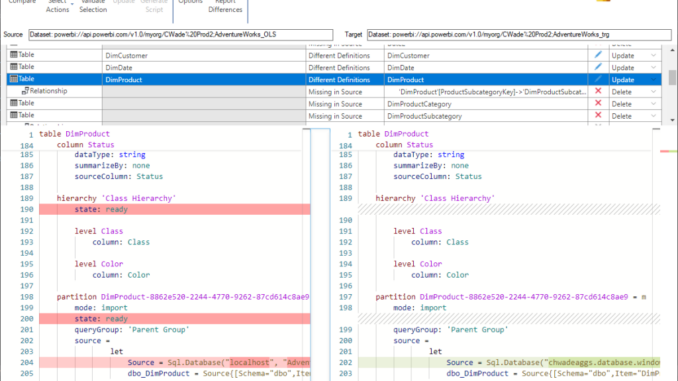
We’re excited to announce that the ALM Toolkit now supports diffs of semantic model definitions in the Tabular Model Definition Language (TMDL) format!
Power BI supports enterprise-grade semantic models allowing business users to easily extract actionable insights for intelligent decision-making at massive scale in large organizations.
Such organizations require Git-friendly file formats for Application Lifecycle Management (ALM). TMDL allows you to view semantic model metadata in a human-readable, YAML-like syntax and supports scenarios where data professionals need to make incremental changes to models, collaborate with others, Fabric Git integration, and Power BI Desktop projects. See the TMDL documentation page for more information and Getting Started with TMDL to learn how to start using TMDL today.
A wide range of 3rd party and community tools benefit from rich programmability and open-platform connectivity provided by Power BI semantic models. The ALM Toolkit is one of many such community tools and uses the external tools feature in Power BI Desktop and the XMLA endpoint for programmability in the Power BI service. It is open source, maintained by the AS PM team, and is not a Microsoft supported product. Download and try out the ALM Toolkit from the Analysis Services Git repo to manage your Power BI semantic models.
The ALM Toolkit is a schema comparison tool you can use for scenarios such as:
- Easily deploy changes only to model metadata, whilst retaining data including incremental refresh data.
- Diff & merge across models/repos with guardrails to ensure the integrity of the resulting model metadata. Pick and choose objects to reuse in other models.
- Reuse common objects across models. For example, conformed dimensions, standardized date dimensions, and common measures to be standardized across models.
- Command-line execution for automation.
The latest update to the ALM Toolkit allows you to view semantic model metadata in TMDL format with helpful, easy-on-the-eyes syntactical coloring! For more information on ALM Toolkit, please review the documentation.

We hope you enjoy exploring these features and can’t wait to hear how the ALM Toolkit helps streamline your workflow.

Be the first to comment